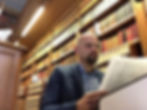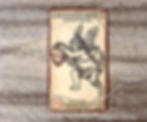The Angel Tarot
- travisdmchenry
- Feb 7, 2021
- 6 min read
The Angel Tarot is a deck of 78 cards that harnesses the power of the 72 Angels of the Shem HaMephorash.
It was released in 2019 as a companion deck to the Demon-Possessed Tarot. The original name for the deck was The Angel-Evoking Tarot. After a very successful Kickstarter campaign, the images on the cards were licensed by Rockpool Publishing and reformatted into the Angel Tarot.

What are the Kabbalistic Angels?
The angels of the Kabbalah (also known as the Shem HaMephorash) are 72 angels that represent the 72-word name of God. These angels have been called upon by Jewish mystics for over a thousand years, and were most likely incorporated into Hermetic practices in the 1300s.
The names of the 72 angels are derived from a specific verse in the Book of Exodus. When this verse is read boustrophedonically in the original Hebrew, there are exactly 72 words, each three letters long. Kabbalists took these 72 words and added the letters EL or IAH to each of them to create the names of the 72 angels.

For example, the first letters derived from this "twisting" method of reading are the Hebrew letters Vav Heh Vav. These letters are then combined to form the word Vehu (the letter V and U are essentially the same letter in ancient Hebrew). Finally, the letters iah (meaning "God") are added to the end to make it the proper name Vehuiah, meaning "The Exalting God."
This process continues throughout the entire verse until all 72 angels have been identified and named. Here is a chart of the names with the Hebrew letters from which they are derived. This chart was created by Francis Barrett for his 1801 book, The Magus, but similar versions can be found as far back as Agrippa's 1531 Occult Philosophy.

What's so special about these 72 angels?
To figure out why we should pay special attention to these specific angels, when there are so many other angels and archangels, we need to examine the passage in Exodus and the theories postulated by the Kabbalists who first analyzed it.
The passage in question is Exodus 14:19-21. It describes how Moses parted the Red Sea and destroyed the armies of the Pharaoh.
Exodus 14 19 And the angel of God, which went before the camp of Israel, removed and went behind them; and the pillar of the cloud went from before their face, and stood behind them:
20 And it came between the camp of the Egyptians and the camp of Israel; and it was a cloud and darkness to them, but it gave light by night to these: so that the one came not near the other all the night.
21 And Moses stretched out his hand over the sea; and the Lord caused the sea to go back by a strong east wind all that night, and made the sea dry land, and the waters were divided.
The Kabbalists believed that Moses didn't just "call upon God," but that he actually said the entire 72-word name of God to invoke this incredible Divine power. They reasoned that if these words could perform a miracle of that magnitude, then there must be some truly profound power in this passage.
Adoption by European (Christian) Occultists
In the 1300s - 1400s, European alchemists, astrologists, and scholars developed an intense interest in magic. They blended Arab and Jewish mystical traditions into their existing Greek-Egyptian Hermetic practices. During this process, they began to assign specific attributes to the 72 angels.
Each one was given a specific office or power and organized into angelic choirs. The most interesting Hermetic addition was the assigning of Angels to different astrological signs. Because there are 72 angels, this fit in nicely with the 36 decans of the Zodiac. Each angel was assigned a day decan and a night decan, making a total of 72.
Further, the angels were presumed to influence people who had been born during the hour and day associated with those angels. From this tradition, we get our guardian angels, which has been drastically reinterpreted over the past 600 years to become the commercialized phenomena we know today.
Authenticating the Sources
Most of the Hermetic literature expounding on the traits and powers of the 72 angels are in French or Latin and have been badly misinterpreted by modern authors who misunderstood the meaning of the original Hebrew text.
These mysteries could only be solved by tracking down the original texts that contained the earliest information about these angels. Many of these old grimoires have already been digitized and are available for study if you know where to look (and can understand French or Latin).

The most important historical book on angel magic is an unpublished handwritten manuscript from the 1600s currently in the Arsenal Library in Paris. The only way to access this text is to pass a series of interviews (in French) and then visit the Arsenal Library in person.
In late 2018, I undertook this journey, and after some considerable effort, was able to study this book, along with two other unpublished versions of the Clavicle of Solomon, both dating from the same period. The BNF was very accommodating and provided me with a private room where I spent hours examining and translating these texts.

This is where I found the original source for the summoning sigils for the 72 Angels of the Kabbalah. Robert Ambelain's Practical Kabbalah contains his own poorly drawn tracings of these sigils, but I was able to use a camera to take high-definition photographs of all 72 sigils, plus the sigils of the Archangels of the Zodiac, which were hitherto unknown to most Occultists.
Creating the Angel Tarot
After collecting this vast trove of information about the 72 angels, I was ready to begin the process of creating a Tarot deck based around their abilities.
The correspondence between each card and an angel involved matching that angel's specific ability with the classic (Golden Dawn) meaning behind the Tarot card. The appropriate summoning sigils were added to the card so they could be utilized for evocation and ritual work and not merely as tools of divination.

Approximately half of the images of angels in the deck were drawn by three artists commissioned by me to create original artwork that paired with the office of the angel and/or the name of the Tarot. The rest of the drawings were collected from books in the public domain. Some people have criticized the artwork as "not what the angels look like." This is a rather silly argument because it suggests these critics have seen all 72 angels with their own eyes and can say for certain what they do or do not look like!
Because there are 78 cards in a Tarot deck, but only 72 Kabbalistic angels, I had to add six additional angels. This was a very challenging process that required difficult decisions. In the end, I selected Michael, Uriel, Samael, Haniel, Metatron, and Gabriel. This is based on the correspondence of their attributes or abilities with the Tarot cards that remained unassigned to the 72 angels.

How do you assign an angel to The Devil card? Samael, who is described in the Grimoire of Armadel as teaching necromancy, is described extensively in Jewish Kabbalistic literature as a destroying angel, as a fallen angel, and as the spirit who tormented Job. Even A.E. Waite describes Samael as the "Severity of God." There is no better angel to assign to The Devil card than him. My research and thought process for the other angels is the same.
Where is Raphael?!
The single biggest question I get about the Angel Tarot is about the absence of Archangel Raphael. There are two reasons he is missing:
First, the Angel Tarot is devoted primarily to the 72 Angels of the Kabbalah or Shem HaMephorash. Raphael is not one of those angels.
Second, he was originally in my list of powerful archangels that would be added to the Major Arcana cards, but I quickly realized that his primary ability, that of healing (the name Raphael means "God Heals") was already shared by many of the existing Kabbalistic angels. Rather than add in another "doctor" when so many already existed in the deck, I opted to select a different archangel to fill out the final six places.
The absence of Raphael in this deck does not prevent anyone from evoking him and working with him. As powerful as he is, Raphael simply didn't fit into the allotted space.
Due to the massive demand for Raphael, I'm planning on adding him into a future edition as an alternate Major Arcana card. I'm a big believer in "Give the people what they want."
The Angel Tarot may be purchased at Amazon, at Barnes & Noble, or at most metaphysical / occult bookstores.

